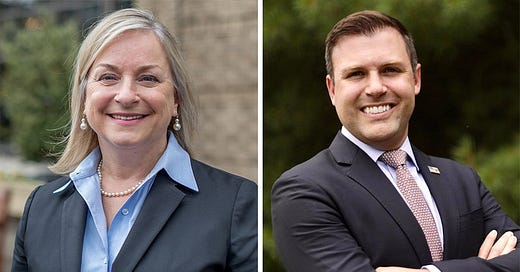Campaign spending in 7th District again tops U.S. House races in Pennsylvania
Nearly $37 million was spent on the 2024 7th District congressional election, where Republican Ryan Makenzie defeated three-term incumbent Democrat Susan Wild, making it the costliest House race in Pennsylvania for the second consecutive election.
The second most expensive House race in the state wasn’t far behind. The campaign in the 8th District, north of the Lehigh Valley, cost more than $32 million, as another Republican, Rob Bresnahan, unseated six-term Democrat Matt Cartwright.
AdImpact, which tracks TV advertising for political campaigns, determined that the Bresnahan-Cartwright and Mackenzie-Wild contests ranked eighth and ninth, respectively, for money spent on ads in House races nationwide. Those two congressional races were part of a trend where federal campaign spending increased since 2020.
In 2020, a presidential election year, spending on all federal contests totaled $15.1 billion, the most ever, according to OpenSecrets, a nonprofit group that tracks campaign finances. A final analysis for 2024 isn’t available yet, but OpenSecrets estimated the 2024 election spending could reach $16 billion.
In its review, Armchair Lehigh Valley examined campaign finance data, which included year-end reports filed Jan. 31 with the Federal Election Commission, and information from OpenSecrets. The totals reflect money spent by the campaigns and independent groups, including super PACs, to support and oppose candidates.
The Republican Party and conservative groups successfully targeted Wild and Cartwright to flip the districts in the party’s attempt to maintain control of the House. Like Wild, the Cartwright campaign raised more money than his opponent’s.
Berwood Yost, director of the Floyd Institute for Public Policy Center and director of Opinion Research at Franklin & Marshall College in Lancaster, said more spending doesn’t necessarily lead to an election night victory.
“There is a point at which additional spending starts to have diminishing returns,” he said, noting campaigns need an effective message to win.
“In the case of the incumbent Democrats who lost, the spending probably kept them competitive in an environment that was incredibly unfavorable for their party. President Biden was widely unpopular as were his policies, particularly around immigration and the economy, and that was going to be difficult to overcome for a Democrat in a competitive race.”
Independent groups played a huge part in the campaigns in both districts, spending more than $20 million in the 7th and $19.2 million in the 8th on TV and direct mail advertising and voter outreach, according to FEC data.
For 2024, PACs as well as committees of political parties and elected officials were limited in what they can give to a candidate in an election cycle, from $2,000 to $5,000, depending on the group.
But super PACs, which grew out of the Supreme Court’s 2010 Citizens United decision, have no such limits on what they can spend on themselves. They also can raise unlimited amounts of money without having to reveal their donors.
Chris Borick, director of Muhlenberg College’s Institute of Public Opinion in Allentown, said court decisions such as Citizens United “largely opened the floodgates to unbridled campaign spending. Legislative attempts to place even modest constraints on spending have largely been thrown out by court rulings that find such laws to be in violation of First Amendment free speech protections.”
He added, “Simply put the demand for resources is elevated by the intense competition. Taken together these factors create fertile soil to grow campaign spending to the historic levels we saw in 2024, and likely will see in upcoming cycles.”
Yost said more money spent on political campaigns gives voters more information, but there is a negative aspect.
“One of the downsides of this spending,” he said, “is understanding where all this money comes from, that is being able to identify who is giving, and understanding what benefits accrue to those who give in large amounts, that is, what benefits do donors expect for their dollars.”
7th District
In 2022, when Wild defeated Republican Lisa Scheller, the total money raised by their campaigns combined with outside spending reached $34 million, about $3 million less than what was spent for the 2024 campaign between Wild and Mackenzie.
With the advantage of incumbency, the Wild campaign outspent Mackenzie by a margin of more than 4-1 ($8.9 million to $1.7 million).
But the independent spending for the candidates was virtually even, with $10.4 million spent to oppose Wild and nearly $10 million to oppose Mackenzie. Political action committees, however, spent considerably more ($4.5 million) to support Wild than those supporting Mackenzie ($1.4. million).
A major supporter of Mackenzie was the Koch-backed PAC, Americans For Prosperity Action, which spent nearly $1.1 million between the primary and the general election to boost his candidacy and another $225,000 to oppose Wild.
(In the race for U.S. Senate in Pennsylvania, AFP Action spent $12.6 million to support Republican Dave McCormick, who won the election, and nearly $7 million in ads and other activities critical of his opponent, incumbent Democrat Bob Casey.)
Independent spending by the numbers
Total opposing Mackenzie: $9,996,349
Top spenders
House Majority PAC – $6,779,140
Democratic Congressional Campaign Committee – $1,096,463
Pro-Choice Majority 2024 – $673,916
Voter Protection Project – $461,334
League of Conservation Voters Victory Fund – $354,687
Total supporting Mackenzie: $1,432,196
Top spenders
Americans For Prosperity Action Inc. (AFP Action) – $1,086,419
Congressional Leadership Fund – $230,720
National Rifle Association of America Political Victory Fund – $58,909
Patriots for a Brighter America – $16,700
Total opposing Wild: $10,424,863
Top spenders
Congressional Leadership Fund – $9,440,541
National Republican Congressional Committee – $758,590
Americans For Prosperity Action Inc. (AFP Action) – $225,521
Total supporting Wild: $4,583,790
Top spenders
Project 218 – $2,137,100
National Association of Realtors Congressional Fund – $789,777
American Hospital Association PAC – $350,000
House Majority PAC – $266,479
Democratic Congressional Campaign Committee – $201,613
Source: FEC reports




